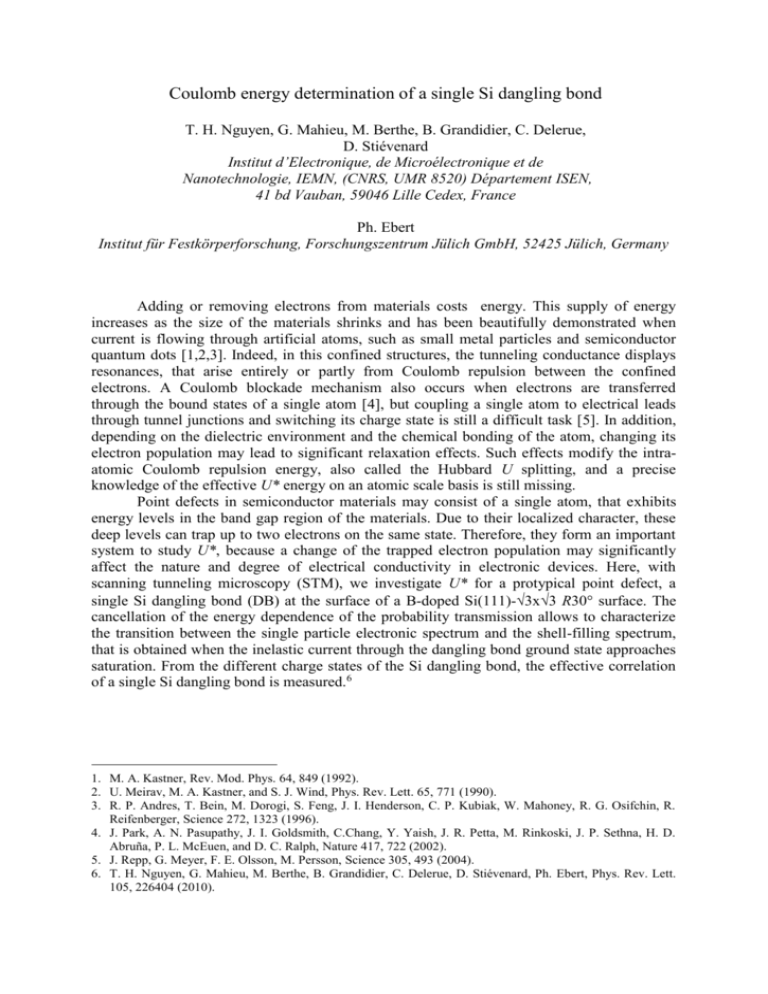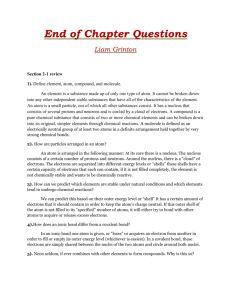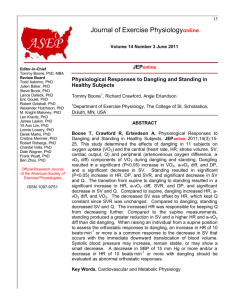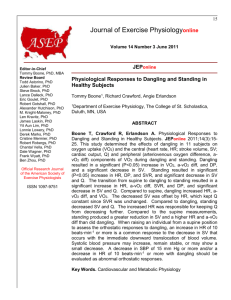Atomic scale structure of Si nanowire
advertisement

Coulomb energy determination of a single Si dangling bond T. H. Nguyen, G. Mahieu, M. Berthe, B. Grandidier, C. Delerue, D. Stiévenard Institut d’Electronique, de Microélectronique et de Nanotechnologie, IEMN, (CNRS, UMR 8520) Département ISEN, 41 bd Vauban, 59046 Lille Cedex, France Ph. Ebert Institut für Festkörperforschung, Forschungszentrum Jülich GmbH, 52425 Jülich, Germany Adding or removing electrons from materials costs energy. This supply of energy increases as the size of the materials shrinks and has been beautifully demonstrated when current is flowing through artificial atoms, such as small metal particles and semiconductor quantum dots [1,2,3]. Indeed, in this confined structures, the tunneling conductance displays resonances, that arise entirely or partly from Coulomb repulsion between the confined electrons. A Coulomb blockade mechanism also occurs when electrons are transferred through the bound states of a single atom [4], but coupling a single atom to electrical leads through tunnel junctions and switching its charge state is still a difficult task [5]. In addition, depending on the dielectric environment and the chemical bonding of the atom, changing its electron population may lead to significant relaxation effects. Such effects modify the intraatomic Coulomb repulsion energy, also called the Hubbard U splitting, and a precise knowledge of the effective U* energy on an atomic scale basis is still missing. Point defects in semiconductor materials may consist of a single atom, that exhibits energy levels in the band gap region of the materials. Due to their localized character, these deep levels can trap up to two electrons on the same state. Therefore, they form an important system to study U*, because a change of the trapped electron population may significantly affect the nature and degree of electrical conductivity in electronic devices. Here, with scanning tunneling microscopy (STM), we investigate U* for a protypical point defect, a single Si dangling bond (DB) at the surface of a B-doped Si(111)-3x3 R30° surface. The cancellation of the energy dependence of the probability transmission allows to characterize the transition between the single particle electronic spectrum and the shell-filling spectrum, that is obtained when the inelastic current through the dangling bond ground state approaches saturation. From the different charge states of the Si dangling bond, the effective correlation of a single Si dangling bond is measured.6 1. M. A. Kastner, Rev. Mod. Phys. 64, 849 (1992). 2. U. Meirav, M. A. Kastner, and S. J. Wind, Phys. Rev. Lett. 65, 771 (1990). 3. R. P. Andres, T. Bein, M. Dorogi, S. Feng, J. I. Henderson, C. P. Kubiak, W. Mahoney, R. G. Osifchin, R. Reifenberger, Science 272, 1323 (1996). 4. J. Park, A. N. Pasupathy, J. I. Goldsmith, C.Chang, Y. Yaish, J. R. Petta, M. Rinkoski, J. P. Sethna, H. D. Abruña, P. L. McEuen, and D. C. Ralph, Nature 417, 722 (2002). 5. J. Repp, G. Meyer, F. E. Olsson, M. Persson, Science 305, 493 (2004). 6. T. H. Nguyen, G. Mahieu, M. Berthe, B. Grandidier, C. Delerue, D. Stiévenard, Ph. Ebert, Phys. Rev. Lett. 105, 226404 (2010).









